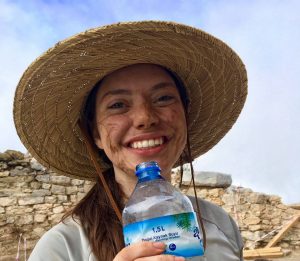
5:10 AM … I wake up at the Dig House to the sound of roosters and phone alarms. I roll out of bed.
5:30 AM … After I fill my water bottle at the cooler, I board the bus. We stop at Total gas station for snacks. I sleep on the way to the site.
6:00 AM … We eat breakfast, the most important meal of the day. Wasps attack the jam and unsuspecting students.
6:30 AM … The 13 Ole team climbs to the Acropolis. We immediately lather sunscreen onto our legs and arms. We put on our gloves and collect the trowels, pickaxes, dust pans, and buckets. It’s time to work!
Gabriel, Amanda, Mary, and I (Gamma Squad) work in AC6A and AC6B. We believe AC6 to be an apsidal chapel. A second apsidal chapel lies beneath the larger, later church to the south of AC6. The two sister chapels (?) match in size. Today, I hope to find the last steps of the staircase that descends into the western entrance of AC6. I use a trowel for detailed work and articulation. I use a pickaxe to break the compact soil and to remove large stones. I know to remove a stone when no mortar connects the stone to a wall or other planned structure. If I am unsure whether to remove or preserve a stone, I record its placement with a photograph or drawing.
I uncover fragments of roof tiles near the staircase. Roof tiles are not bagged with pottery and are instead piled to the side. I find the bottom of the staircase. Three stairs are fractured. The fourth stair is stable. The dimpled texture of the bottom stair indicates that the stone might be bedrock. This last stair is level with the bedrock and tile path (?) at the western backend of AC6. We believe the steps to be a later edition because the staircase is cut from the southern wall. The AC6 chapel seems re-purposed. We are still investigating what purpose the structure may have served during later years.
10:00 AM … The Oles climb down from the Acropolis to meet the Turkish students at the baths for chai break. We share cookies with one another.
10:30 AM … Return to work at the Acropolis
After I finish digging the staircase area, I shift my efforts toward the western entrance. I use a trowel, dustpan, and bucket to remove soil. I find a bronze coin the size of a penny above a flat rock (the threshold?). At first, I believe the object to be schist, a shiny material. Schist, I learn, is much lighter than coin. This object is heavy for its small size and has a bumpy surface. I found a coin, not schist! Once cleaned, the coin might give us information about the site, including dates. My team takes elevations of the coin using a level, stadia rod, and scales. I bag the coin and record my findings in the field notebook.
1:00 PM … Lunch and chai
2:00 PM … Shower and nap at the Dig House
4:00 PM … Draw and clean pottery
7:00 PM … Dinner and chai
7:30 PM … Reports and discussion
Just Some Turkish Things:
• Çok sicak: Very hot
• Textile market
• Drinking four liters of water per day
• Suyu: H2O
• Oh Schist.

You must be logged in to post a comment.